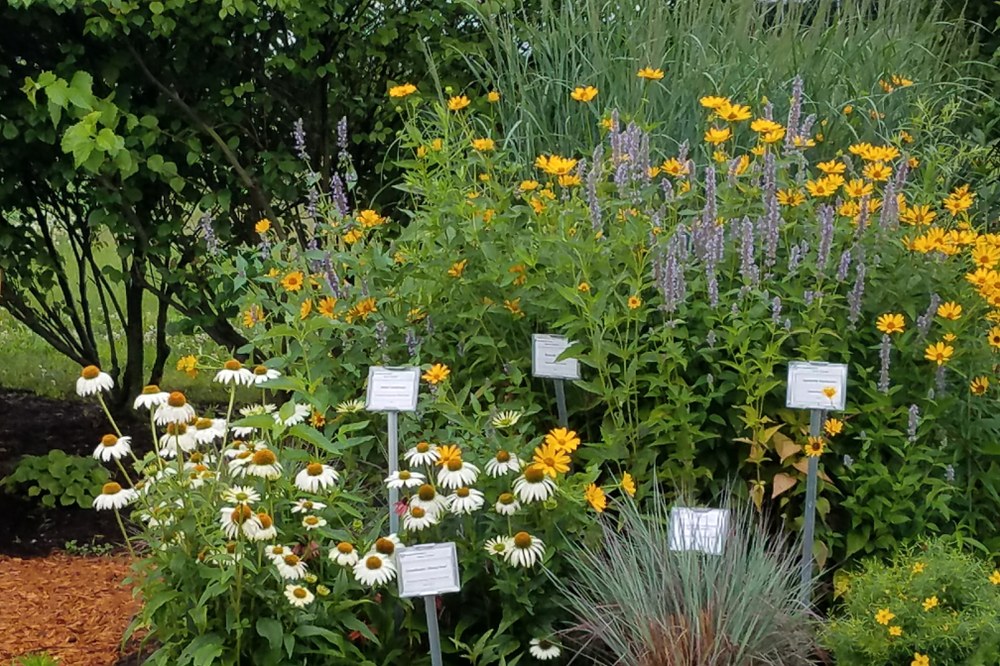Posted: July 8, 2021
Gardening involves projects that can be done every year at the same time. Though annual weather may influence the timing of these tasks, here are the things to do in July.

Native Garden at South East Agricultural Research and Extension Center. Photo and article by Pam Hall.
Watering becomes necessary for the plants and the gardener.
Did you know that July is the hottest month of the year in Lancaster, Pennsylvania? The heat index is estimated at a hot 90.9 degrees with an average relative humidity of 79%. We must help our plants by watering them, but we must take special precautions for ourselves. Drink plenty of liquids and take regular breaks from the sun. Heat exhaustion tips.
When should we water our plants?
Watering in the morning between 6:00-10:00 am, prepares the plant for the day and the plant has time to dry before the sun goes down. We do not recommend watering in the evening because water tends to rest in the soil, around the roots, and on foliage, which encourages rot, fungal growth, and insects. When to water.
How to water.
Water the roots, keeping the nozzle close to the ground. We are not firefighters-do not hold the hose and water by spraying the entire plant. All plants need to be watered but it is especially important to water both seedlings and young transplants. Mulching helps to retain moisture so add mulch to your garden where needed. How to water.
How much should I water.
Remember that rain gauge I recommended in the spring? Flower gardens require only 1 inch of water each week. If you do not have a rain gauge, put out a straight-edged can and a ruler to give you the same information. Knowing when to water flowers in hot weather can be tricky-if you think they are not getting enough moisture, check the top 3" of soil. It should be consistently moist. Watering.
Can I overwater my flowering plants?
The answer is a definite yes. When you overwater your plants, you are putting them at risk of fungal pathogens which can lead to root rot and other issues. The plant's colors dull and turn yellow, then become soft and break easily. As the roots decay plants will eventually die. Overwatering.
Keep weeding.
Weeding is a never-ending garden task, and even during hot July days. It is essential to remove unwanted plants that compete for water and soil nutrients. Weeds are easier to pull when soil is damp, so it can be better to weed immediately after watering the garden.
Deadhead flowers.
Native flowering perennials should be deadheaded in July. Simply cut off or pinch off spent blooms. A perennial plant's goal in life is to propagate; plants propagate from seeds, and flowers make the seeds. By deadheading perennials, flowers will continue to bloom profusely for several weeks. More flowers also mean more benefits to pollinators. Deadheading Helps Next Season.
Is it too late to plant perennials in July?
Planting in July is fine if you water them well until they are established. Plant early in the day or in the evening; never mid-day.
Provide birds and butterflies with a water source.
Plants are important for attracting native wildlife and insects however, water is also a wonderful and necessary attractant to wildlife. Birds need a place for drinking and preening, as they need to keep their feathers clean to stay alive. Male butterflies use water for "puddling," in which they retrieve nourishment needed for mating. Use a soaker hose to or daily watering a spot keeping soil moist. Native Bees also need water, but they will drown in a birdbath. Put out a shallow water container and fill it with pebbles. The bees will sit on the pebbles while they drink. How to provide water for birds and butterflies.

